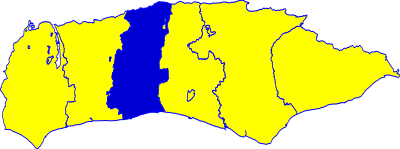Difference between revisions of "Rape of Bramber"
| Line 13: | Line 13: | ||
==Relationship to Sussex, western division== | ==Relationship to Sussex, western division== | ||
| − | Until the creation of the rape of Bramber, Sussex had been divided into east and west at the River Adur, at least for the purposes of the church in Sussex<ref name="VCHSxChi">{{cite web|url=http://www.british-history.ac.uk/report.aspx?compid=41682|title=Victoria County History - The rape of Chichester|publisher=British History Online|accessdate=31 July 2010}}</ref> (divided from at least the 11th century into the | + | Until the creation of the rape of Bramber, Sussex had been divided into east and west at the River Adur, at least for the purposes of the church in Sussex<ref name="VCHSxChi">{{cite web|url=http://www.british-history.ac.uk/report.aspx?compid=41682|title=Victoria County History - The rape of Chichester|publisher=British History Online|accessdate=31 July 2010}}</ref> (divided from at least the 11th century into the archdeaconry of Chichester and the archdeaconry of Lewes). After the creation of the rape of Bramber, the rape became one of the three rapes traditionally making up the western division of the county of Sussex. |
==Sub-divisions== | ==Sub-divisions== | ||
The rape is divided into the following hundreds: | The rape is divided into the following hundreds: | ||
| − | * [[ | + | * [[Brightford]] |
| − | * [[ | + | * [[Burbeach]] |
* [[Horsham Hundred|Horsham]] | * [[Horsham Hundred|Horsham]] | ||
* [[Patching Hundred|Patching]] | * [[Patching Hundred|Patching]] | ||
| − | * [[ | + | * [[Singlecross]] |
* [[Steyning Hudnred|Steyning]] | * [[Steyning Hudnred|Steyning]] | ||
* [[Tarring Hundred|Tarring]] (a peculier of the [[Archbishop of Canterbury]]) | * [[Tarring Hundred|Tarring]] (a peculier of the [[Archbishop of Canterbury]]) | ||
| − | * [[ | + | * [[Tipnoak]] |
* [[West Grinstead Hundred|West Grinstead]] (Grensted in the [[Domesday Book|Domesday Survey]]) <ref name="brandon210">Brandon. South Saxons. pp.209-220. The Domesday Record of Sussex</ref> | * [[West Grinstead Hundred|West Grinstead]] (Grensted in the [[Domesday Book|Domesday Survey]]) <ref name="brandon210">Brandon. South Saxons. pp.209-220. The Domesday Record of Sussex</ref> | ||
as well as 3 half hundreds | as well as 3 half hundreds | ||
| − | * [[ | + | * [[East Easwrith]] |
| − | * [[ | + | * [[Fishergate]] |
* [[Wyndham Hundred|Wyndham]] | * [[Wyndham Hundred|Wyndham]] | ||
Revision as of 11:36, 2 March 2021
The Rape of Bramber is one of the rapes of Sussex, the traditional divisions unique to that county. Bramber is a former barony whose original seat was the castle of Bramber and its village, overlooking the River Adur. The rape had a population of 357,326 in 2011.
Contents
History
Created by William the Conqueror in the late 11th century, the rape of Bramber was separated out of the neighbouring rapes of Arundel and Lewes and entrusted to one of his knights, William de Braose, 1st Lord of Bramber. It was inserted so William de Braose could defend the Adur estuary, and a re-allocation of land to existing rapal owners became necessary.[1]
In population terms, the smallest of the three rapes making up Sussex's western division,[2] its population in 1801 was 19,203,[2] rising to 22,777 in 1811[2] and 30,113 in 1831.[3]
Location
The rape of Bramber is a strip of territory running northwards from the coast to the border with Surrey in the north. It is bordered by the rape of Arundel to the west and the rape of Lewes to the east. It contains a variety of different landscape areas - coastal plain and the mouth of the river Adur in the south, the South Downs and the Weald north of that, including the westernmost part of the dense Forest Ridge, known in the rape of Bramber as St Leonard's Forest. In the neighbouring rape of Lewes, the Forest Ridge is known as Worth Forest. The rape contains five towns: Horsham, Shoreham-by-Sea, Steyning and most of the borough of Worthing, as well as the westernmost part of the borough of Crawley. The ancient parish of Ifield lies in the far north-east of Bramber rape, and in its own north-east corner on Lowfield Heath grew the County Oak, which marked the Sussex-Surrey boundary, as well as the boundary between the rapes of Bramber and Lewes.[4] The oak was cut down in the 1840s and is remembered today in the County Oak Retail Park in Crawley. The highest point in the rape is Chanctonbury Ring at 794 ft tall.
Relationship to Sussex, western division
Until the creation of the rape of Bramber, Sussex had been divided into east and west at the River Adur, at least for the purposes of the church in Sussex[5] (divided from at least the 11th century into the archdeaconry of Chichester and the archdeaconry of Lewes). After the creation of the rape of Bramber, the rape became one of the three rapes traditionally making up the western division of the county of Sussex.
Sub-divisions
The rape is divided into the following hundreds:
- Brightford
- Burbeach
- Horsham
- Patching
- Singlecross
- Steyning
- Tarring (a peculier of the Archbishop of Canterbury)
- Tipnoak
- West Grinstead (Grensted in the Domesday Survey) [6]
as well as 3 half hundreds
Notes
- ↑ Brandon, Peter (2006). Sussex. Phillimore. ISBN 978-0-7090-6998-0.
- ↑ 2.0 2.1 2.2 Dallaway, James (1815). A History of the Western Division of the County of Sussex, Volume 1. T. Bensley.
- ↑ Bell, James (1836). A New and Comprehensive Gazeteer of England and Wales Vol. 1. A Fullarton & Co..
- ↑ http://www.british-history.ac.uk/report.aspx?compid=18405
- ↑ "Victoria County History - The rape of Chichester". British History Online. http://www.british-history.ac.uk/report.aspx?compid=41682. Retrieved 31 July 2010.
- ↑ Brandon. South Saxons. pp.209-220. The Domesday Record of Sussex
References
- Brandon, Peter, ed (1978). The South Saxons. Chichester: Phillimore. ISBN 0-85033-240-0.

